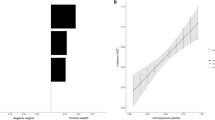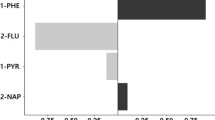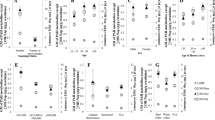Abstract
Polycyclic aromatic hydrocarbons (PAHs) in coke oven emissions cause a cancer risk to humans. In a comprehensive biomonitoring study among Estonian coke oven workers, we looked at the effect of genetic polymorphisms in metabolic enzymes on urinary mutagenicity, 1-hydroxypyrene (1-OHP) concentration in urine, and aromatic DNA adducts in white blood cells (WBCs). Coke oven workers were sampled twice (samplings I and II), and controls only once at the time of sampling I. Urinary mutagenicity was measured using the Ames test. CYP1A1, microsomal epoxide hydrolase (mEH), and glutathione S-transferase (GST) genotypes were analyzed by polymerase chain reaction (PCR). Urinary mutagenicity did not differ between exposed and controls, but those coke oven workers who were smokers had significantly higher (P=0.0002) mutagenic activity in urine than nonsmokers. Urinary mutagenicity was moderately correlated to levels of 1-OHP and aromatic DNA adducts, the P values ranging from 0.0005 to 0.002. Carriers of a variant allele in exon 4 of mEH (Arg139) had elevated urinary mutagenicity (sampling I). In addition, urine mutagenicity of persons with predicted high mEH activity was significantly higher. Smoking habit did not explain the differences observed in urinary mutagenicity between mEH phenotype or genotype subgroups. Variation in exon 3 of mEH (His113) was related to a significantly (P=0.01) higher 1-OHP concentration in exposed workers (sampling II). Workers from sampling I who had an Arg139 variation in mEH had lower levels of adducts in lymphocytes (P=0.01) than others, while airborne benzo[a]pyrene (B[a]P) and His113 variation affected interactively on adduct levels. Our study shows that a comprehensive assessment of exposure is essential for elucidation of PAH exposure at a workplace. Even at high exposures metabolic polymorphisms seem to have some effect on biomarker levels, and should be assessed in biomonitoring studies.
This is a preview of subscription content, access via your institution
Access options
Subscribe to this journal
Receive 6 print issues and online access
$259.00 per year
only $43.17 per issue
Buy this article
- Purchase on Springer Link
- Instant access to full article PDF
Prices may be subject to local taxes which are calculated during checkout





Similar content being viewed by others
Abbreviations
- B[a]P:
-
benzo[a]pyrene
- 1-OHP:
-
1-hydroxypyrene
- PAH:
-
polycyclic aromatic hydrocarbon
- CYP:
-
cytochrome P450
- GST:
-
glutathione S-transferase
- mEH :
-
microsomal epoxide hydrolase
- BPDE:
-
benzo[a]pyrene-dihydrodiol-epoxide
- WBC:
-
white blood cell
- PCR/RFLP:
-
polymerase chain reaction/restriction fragment length polymorphism
- DMSO:
-
dimethyl sulfoxide
- Ile:
-
isoleucine
- Val:
-
valine
- Ala:
-
alanine
- Tyr:
-
tyrosine
- His:
-
histidine
- Arg:
-
arginine
References
Alexandrie AK et al 1994. Genetic susceptibility to lung cancer with special emphasis on CYP1A1 and GSTM1: a study on host factors in relation to age at onset, gender and histological cancer types, Carcinogenesis. 15: 1785–1790
Alexandrie AK et al 2000. CYP1A1 and GSTM1 polymorphisms affect urinary 1-hydroxypyrene levels after PAH exposure, Carcinogenesis. 21: 669–676
Bartsch H et al 1995. Metabolic polymorphism affecting DNA binding and excretion of carcinogens in humans, Pharmacogenetics. 5: S84–90
Bartsch H Hietanen E, 1996. The role of individual susceptibility in cancer burden related to environmental exposure, Environ Health Perspect. 104(Suppl 3): 569–577
Benhamou S et al 1998. Association between lung cancer and microsomal epoxide hydrolase genotypes, Cancer Res. 58: 5291–5293
Bieniek G, 1998. Aromatic and polycyclic hydrocarbons in air and their urinary metabolites in coke plant workers, Am J Ind Med. 34: 445–454
Binkova B et al 1996. Biomarker studies in northern Bohemia, Environ Health Perspect. 104(Suppl 3): 591–597
Binkova B et al 1998. Coke oven workers study: the effect of exposure and GSTM1 and NAT2 genotypes on DNA adduct levels in white blood cells and lymphocytes as determined by 32P-postlabelling, Mutat Res. 416: 67–84
Brockmoller J et al 1992. Correlation between trans-stilbene oxide-glutathione conjugation activity and the deletion mutation in the glutathione S-transferase class mu gene detected by polymerase chain reaction, Biochem Pharmacol. 43: 647–650
Butkiewicz D et al 1998. Modulation of DNA adduct levels in human mononuclear white blood cells and granulocytes by CYP1A1 CYP2D6 and GSTM1 genetic polymorphisms, Mutat Res. 415: 97–108
Carstensen U et al 1999. Influence of genetic polymorphisms of biotransformation enzymes on gene mutations, strand breaks of deoxyribonucleic acid, and micronuclei in mononuclear blood cells and urinary 8-hydroxydeoxyguanosine in potroom workers exposed to polyaromatic hydrocarbons, Scand J Work Environ Health. 25: 351–360
Carstensen U et al 1999. Genotoxic exposures of potroom workers, Scand J Work Environ Health. 25: 24–32
Clonfero E et al Biological monitoring of human exposure to coal tar. Urinary mutagenicity assays and analytical determination of polycyclic aromatic hydrocarbon metabolites in urine In: Vainio H., Sorsa M., McMichael A.J. (Eds.). Complex Mixtures and Cancer Risk IARC Scientific Publication, no. 104, Lyon 1990 215–222
Clonfero E et al 1995. Urinary excretion of mutagens in coke oven workers, Carcinogenesis. 16: 547–554
Daly AK et al 1993. Metabolic polymorphisms, Pharmacol Ther. 57: 129–160
d'Errico A et al 1996. Genetic metabolic polymorphisms and the risk of cancer: a review of the literature, Biomarkers. 1: 149–173
Eaton DL Bammler TK, 1999. Concise review of the glutathione S-transferases and their significance in toxicology, Toxicol Sci. 49: 156–164
Einistö P et al 1990. Sensitivity of Salmonella typhimurium YG1024 to urine mutagenicity caused by cigarette smoking, Mutat Res. 245: 87–92
Fereira Jr. M et al 1994. Determinants of urinary thioethers, D-glucaric acid and mutagenicity after exposure to polycyclic aromatic hydrocarbons assessed by air monitoring and measurement of 1-hydroxypyrene in urine: a cross-sectional study in workers of coke and graphite-electrode-producing plants, Int Arch Occup Environ Health. 65: 329–338
Gabbani G et al 1996. GSTM1 and NAT2 genotypes and urinary mutagens in coke oven workers, Carcinogenesis. 17: 1677–1681
Godschalk RW et al 1998. Aromatic DNA adducts in human white blood cells and skin after dermal application of coal tar, Cancer Epidemiol Biomarkers Prev. 7: 767–773
Grinberg-Funes RA et al 1994. Polycyclic aromatic hydrocarbon–DNA adducts in smokers and their relationship to micronutrient levels and the glutathione-S-transferase M1 genotype, Carcinogenesis. 15: 2449–2454
Gupta RC et al 1982. 32P-postlabeling analysis of non-radioactive aromatic carcinogen DNA adducts, Carcinogenesis. 3: 1081–1092
Hassett C et al 1994. Human microsomal epoxide hydrolase: genetic polymorphism and functional expression in vitro of amino acid variants, Hum Mol Genet. 3: 421–428
Hayashi SI et al 1991. Genetic linkage of lung cancer-associated MspI polymorphisms with amino acid replacement in the heme binding region of the human cytochrome P4501A1 gene, J Biochem. 110: 407–411
Heckbert SR et al 1992. Glutathione S-transferase and epoxide hydrolase activity in human leukocytes in relation to risk of lung cancer and other smoking-related cancers, J Natl Cancer Inst. 84: 414–422
Hemminki K et al 1990. DNA adducts in humans environmentally exposed to aromatic compounds in an industrial area of Poland, Carcinogenesis. 11: 1229–1231
Hemminki K et al 1997. Aromatic DNA adducts in foundry workers in relation to exposure, life style and CYP1A1 and glutathione transferase M1 genotype, Carcinogenesis. 18: 345–350
Hirvonen A, 1995. Genetic factors in individual responses to environmental exposures, J Occup Environ Med. 37(1): 37–43
Hirvonen A et al 1994. Modulation of urinary mutagenicity by genetically determined carcinogen metabolism in smokers, Carcinogenesis. 15: 813–815
Hu X et al 1998. Catalytic efficiencies of allelic variants of human glutathione S-transferase P1-1 toward carcinogenic anti-diol epoxides of benzo[c]phenanthrene and benzo[g]chrysene, Cancer Res. 58: 5340–5343
International Agency for Research on Cancer (IARC) 1983. Polynuclear aromatic compounds: Part 1. Chemical, environmental and experimental data, IARC Monographs on the Evaluation of the Carcinogenic Risk of Chemicals to Humans. Vol. 32: 5–475 IARC, Lyon
International Agency for Research on Cancer (IARC) 1984. Polynuclear aromatic compounds: Part 3. Industrial exposures in aluminum production, coal gasification, coke production, and iron and steel founding, IARC Monographs on the Evaluation of the Carcinogenic Risk of Chemicals to Humans. Vol. 34: 5–218 IARC, Lyon
Jongeneelen FJ et al 1987. Determination of hydroxylated metabolites of polycyclic aromatic hydrocarbons in urine, J Chromatogr. 413: 227–232
Kalina I et al 1998. Cytogenetic monitoring in coke oven workers, Mutat Res. 417: 9–17
Kawajiri K et al 1990. Identification of genetically high risk individuals to cancer by DNA polymorphisms of the cytochrome P450Ia1 gene, FEBS Lett. 263: 131–133
Ketterer B, 1988. Protective role of glutathione and glutathione transferases in mutagenesis and carcinogenesis, Mutat Res. 202: 343–361
Ketterer B et al 1992. The human glutathione S-transferase supergene family, its polymorphism, and its effects on susceptibility to lung cancer, Environ Health Perspect. 98: 87–94
Kuljukka T et al 1997. Assessment of occupational exposure to PAHs in Estonian coke oven plant-correlation of total external exposure to internal dose measured as 1-hydroxypyrene concentration, Biomarkers. 2: 87–94
Kuljukka T et al 1998. Low response in white blood cell DNA adducts among workers in a highly polluted cokery environment, J Occup Environ Med. 40: 529–537
Lewtas J et al 1997. Air pollution exposure–DNA adduct dosimetry in humans and rodents: evidence for non-linearity at high doses, Mutat Res. 378: 51–63
Mielżyńska D et al 1997. Exposure of coke-oven workers to polycyclic aromatic hydrocarbons based on biological monitoring results, Am Ind Hyg Assoc J. 58: 661–666
Miller EC Miller JA, 1981. Mechanisms of chemical carcinogenesis, Cancer. 47(5): 1055–1064
Mooney LA et al 1997. Contribution of genetic and nutritional factors to DNA damage in heavy smokers, Carcinogenesis. 18: 503–509
Motykiewicz G et al 1998. A molecular epidemiology study in women from Upper Silesia, Poland, Toxicol Lett. 96–97: 195–202
Nakachi K et al 1993. Polymorphisms of the CYP1A1 and glutathione S-transferase genes associated with susceptibility to lung cancer in relation to cigarette dose in a Japanese population, Cancer Res. 53: 2994–2999
Nielsen PS et al 1996. Environmental air pollution and DNA adducts in Copenhagen bus drivers — effect of GSTM1 and NAT2 genotypes on adduct levels, Carcinogenesis. 17: 1021–1027
Ovrebo S et al 1998. Glutathione S-transferase M1 and P1 genotypes and urinary excretion of 1-hydroxypyrene in coke oven workers, Sci Total Environ. 220: 25–31
Pemble S et al 1994. Human glutathione S-transferase theta (GSTT1): cDNA cloning and the characterization of a genetic polymorphism, Biochem J. 300: 271–276
Pyy L et al 1997. Ambient and biological monitoring of exposure to polycyclic aromatic hydrocarbons at a coking plant, Sci Total Environ. 199: 151–158
Rannug A et al 1995. Genetic polymorphism of cytochromes P450 1A1, 2D6 and 2E1: regulation and toxicological significance, J Occup Environ Med. 37(1): 25–36
Reddy MV Randerrath K, 1986. Nuclease P1-mediated enhancement of sensitivity of 32P-postlabeling test for structurally diverse DNA adducts, Carcinogenesis. 7: 1543–1551
Rojas M et al 1995. Anti-benzo[a]pyrene diolepoxide–DNA adduct levels in peripheral mononuclear cells from coke oven workers and the enhancing effect of smoking, Carcinogenesis. 16: 1373–1376
Rojas M et al 1998. High benzo[a]pyrene diol-epoxide DNA adduct levels in lung and blood cells from individuals with combined CYP1A1 MspI/Msp-GSTM1*0/*0 genotypes, Pharmacogenetics. 8: 109–118
Rothman N et al 1995. The impact of glutathione S-transferase M1 and cytochrome P450 1A1 genotypes on white-blood-cell polycyclic aromatic hydrocarbon–DNA adduct levels in humans, Mol Carcinog. 14: 63–68
VanRooij JGM et al 1993. Estimation of individual dermal and respiratory uptake of polycyclic aromatic hydrocarbons in 12 coke oven workers, Br J Ind Med. 50: 623–632
Van Schooten FJ et al 1997. 32P-postlabelling of aromatic DNA adducts in white blood cells and alveolar macrophages of smokers: saturation at high exposures, Mutat Res. 378: 65–75
Warholm M et al 1995. Genotypic and phenotypic determination of polymorphic glutathione transferase T1 in a Swedish population, Pharmacogenetics. 5: 252–254
Watanabe M et al 1990. Sensitive method for the detection of mutagenic nitroarenes and aromatic amines: new drivatives of Salmonella typhimurium tester strains possessing elevated O-acetyltransferases levels, Mutat Res. 245: 337–348
Acknowledgements
The authors thank the volunteers of the RAS “Kiviter” plant who participated in this study and other employees whose contribution was essential in this study. The personnel of Institute of Experimental and Clinical Medicine, in Tallinn are thanked for practical arrangements on site. Diari Ghafouri is thanked for skillful performance of the genotype analyses. All the employees of Finnish Institute of Occupational Health are thanked for their contribution during this study. The research was supported by the Academy of Finland, and the CEC project ERBCIPA CT92-3016.
Author information
Authors and Affiliations
Corresponding author
Rights and permissions
About this article
Cite this article
KULJUKKA-RABB, T., NYLUND, L., VAARANRINTA, R. et al. The effect of relevant genotypes on PAH exposure-related biomarkers. J Expo Sci Environ Epidemiol 12, 81–91 (2002). https://doi.org/10.1038/sj.jea.7500204
Received:
Published:
Issue Date:
DOI: https://doi.org/10.1038/sj.jea.7500204



